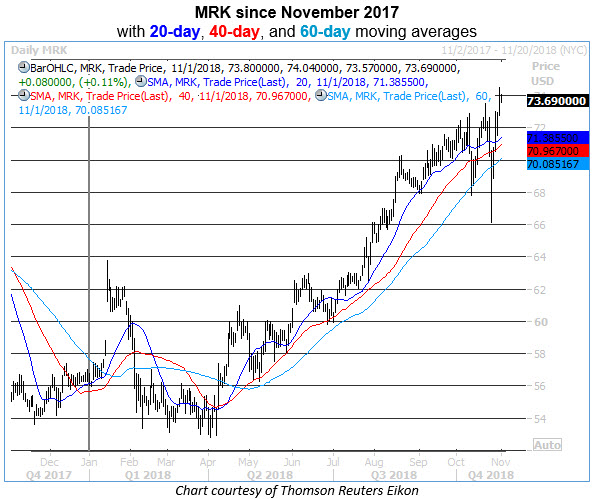Despite heavy selling and widespread volatility, at least one Dow component emerged relatively unscathed. Merck & Co., part of the traditionally defensive big-cap pharmaceutical sector, set a fresh 17-year high of $74.49 as recently as Oct. 31, writes Elizabeth Harrow.
The shares have gained roughly 31% year-to-date, but the stock is currently bouncing from multiple layers of technical support -- suggesting that this blue-chip name could be due for more upside in the weeks to come.
Since early in the second quarter of 2018, the Merck (MRK) uptrend has been highlighted by the rising support of its 20-day and 40-day moving averages, which have guided the stock steadily higher. The recent bout of broad-market volatility carried the shares down to a test of their longer-term 60-day trendline, as well as the $68 neighborhood -- in the vicinity of a 20% year-to-date return. Support here held up admirably well, and MRK has since powered to new highs.

Notably, prior pullbacks to support at the 40-day moving average, in particular, have delivered positive returns for MRK over the next month. Following the stock's recent dip to within one standard deviation of this trendline, data from Schaeffer's Senior Quantitative Analyst Rocky White shows that seven comparable pullbacks by MRK over the past three years have yielded 67% positive returns over the next 21 days, with an average return of 2.79%.
However, options traders have been loading up on MRK put options. During the past 10 sessions, speculative players on the International Securities Exchange (ISE), Chicago Board Options Exchange (CBOE), and NASDAQ OMX PHLX (PHLX) have bought to open 1.10 puts for every call on the stock. This ratio arrives in the 99th percentile of its annual range, as traders have rarely shown a greater preference for bearish bets over bullish.
With MRK trading near annual highs, some of this put buying could be the result of shareholders looking to lock in paper profits against a possible downturn. Regardless, the skeptically slanted option volume has driven put option premiums considerably higher than their call counterparts, as evidenced by the stock's 30-day implied volatility (IV) skew of 22.1%. According to Trade-Alert, this reading registers in the 97th percentile of its annual range, indicating an unusually steep put skew is being priced into MRK options at the moment.
From a broader perspective, though, options on the drug stock are fairly priced, on an IV basis. With Merck's third-quarter earnings report already in the rearview, 30-day at-the-money IV of 19% arrives in the middling 54th percentile of its annual range. And narrowing the focus to standard monthly November-dated options, our Schaeffer's Volatility Index (SVI) of 21% ranks in the modest 34th annual percentile.
Fortunately for prospective call buyers, MRK tends to outperform the volatility expectations priced into its options. The stock sports a Schaeffer’s Volatility Scorecard (SVS) of 89 out of a possible 100, which means it has regularly exceeded the at-the-money IV levels priced into its options over the past year. In other words, this is a name that has consistently rewarded premium buyers with its price action.
With solid support in place and some skepticism still lingering toward the standout Dow stock, MRK looks primed for more upside in the days ahead. By buying call options, traders can limit their dollars at risk in this volatile market, while simultaneously leveraging any further gains in the stock.
View Schaeffer’s Investment Research for stock and options ideas, options education, and market commentary here
John Vandermosten: Biotech Idea Merck in a short video at MoneyShow Dallas here.
John Vandermosten of Zacks Investment Research: one area big in cancer drugs has been checkpoint inhibitors, like Keytruda from Merck. They work well in about 20% of people.





















